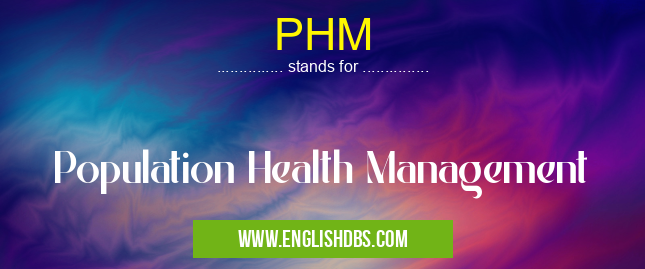What does PHM mean in HEALTHCARE
Population Health Management (PHM) is an approach to healthcare that promotes the health of individuals and communities through prevention, early detection, treatment and follow-up of chronic conditions. PHM relies on a comprehensive understanding of population health and uses data to inform interventions and assess impact. PHM focuses on improving the lives of individuals while reducing costs and utilization at the same time. It has become increasingly important in today’s healthcare system as payers and providers seek ways to better manage care for patients.

PHM meaning in Healthcare in Medical
PHM mostly used in an acronym Healthcare in Category Medical that means Population Health Management
Shorthand: PHM,
Full Form: Population Health Management
For more information of "Population Health Management", see the section below.
» Medical » Healthcare
What is Population Health Management (PHM)?
Population Health Management (PHM) is the practice of using tools such as data analytics, predictive modeling, patient outreach, resource allocation, preventive care coordination, and more to improve the overall well-being of people in a specific population. It involves understanding the socio-economic factors that can affect health outcomes as well as recognizing demographic trends and other environmental issues that may have an effect on individuals or groups. PHM seeks to identify potential risks for disease or illness before they occur so that proactive measures can be taken to prevent them. Additionally, it looks to reduce costs by decreasing unnecessary utilization while promoting better access to quality care for all members of a population.
How Does PHM Work?
Population Health Management utilizes data from multiple sources to gain insights into health trends within a given population. This information helps healthcare providers focus their efforts where they will provide the most benefit. For example, if high rates of obesity are found in a certain area then approaches like nutrition classes or walking clubs may be targeted towards individuals there in order to promote healthier habits among them. In addition, resources such as primary care physicians may be allocated where needed most according to data gained from the program's analysis. With these measures being put into place with the goal of improving overall wellness for all members of a population, it is possible that future healthcare costs may be reduced while achieving better health outcomes at the same time.
Essential Questions and Answers on Population Health Management in "MEDICAL»HEALTHCARE"
What is Population Health Management?
Population Health Management (PHM) is a systematic approach to improving the health of individuals and controlling healthcare costs. It looks at a population’s overall health over time, providing an organized and structured way to identify health risks, develop prevention strategies, and measure their effectiveness.
How does PHM benefit patients?
By approaching healthcare from a population-level perspective, PHM can detect potential issues before they become full-blown problems, and provide proactive healthcare options that help increase patient satisfaction while preventing more acute or chronic conditions.
Can PHM be applied to any size group or population?
Yes - regardless of the size of the group or population, PHM can be tailored to meet its needs. Whether you’re managing care for a large city or small town, it can help improve outcomes for everyone involved.
What is included in PHM?
Population Health Management includes activities such as risk stratification, wellness initiatives, preventive care management services, clinical intervention programs and other strategies that are designed to improve overall patient health and reduce the burden on the healthcare system.
What kind of data does PHM analyze?
Population Health Management uses medical claims data as well as non-clinical information such as socioeconomic factors and lifestyle choices to understand how different populations interact with the healthcare system.
Who typically manages a Population Health program?
A variety of stakeholders are involved in managing a Population Health program – providers, payers/insurers, employers/trade associations and government organizations often collaborate to manage these types of initiatives.
What role does technology play in PHM?
Technology plays an integral part in executing successful Population Health programs – from efficiently collecting data from multiple sources to providing consistent monitoring of metrics across all patient populations. The right technology platform can enable rapid scalability when necessary while also providing actionable insights about population trends.
Does PHM require extra paperwork for practitioners?
No - most platforms have automated processes that allow practitioners to focus on delivering quality care without having to worry about tedious paperwork or take up valuable time completing tasks manually.
What kind of results has been seen with successful PHM implementations?
Successful implementations have seen improved quality scores for both providers and facilities; lower costs due to fewer ER visits; reduced hospital admissions; readmissions; improved patient engagement; lower mortality rates; increased adherence to recommended protocols; better operational efficiency; increased staff productivity; improved compliance with industry standards; increased revenue cycle management successes; decreased administrative expenses; greater market preparedness for value-based purchasing models among payers/payers etc
Final Words:
Population Health Management (PHM) has become increasingly important in our modern healthcare system due to its ability to identify potential risks before they develop into full-blown illnesses and diseases while helping reduce costs associated with medical care for those affected by them. Through leveraging data from multiple sources combined with evidence-based interventions targeted specifically towards populations at risk; PHM is able to create a positive impact on morbidity rates across an entire community or region rather than just one individual patient which results in improved health outcomes overall.
PHM also stands for: |
|
| All stands for PHM |
